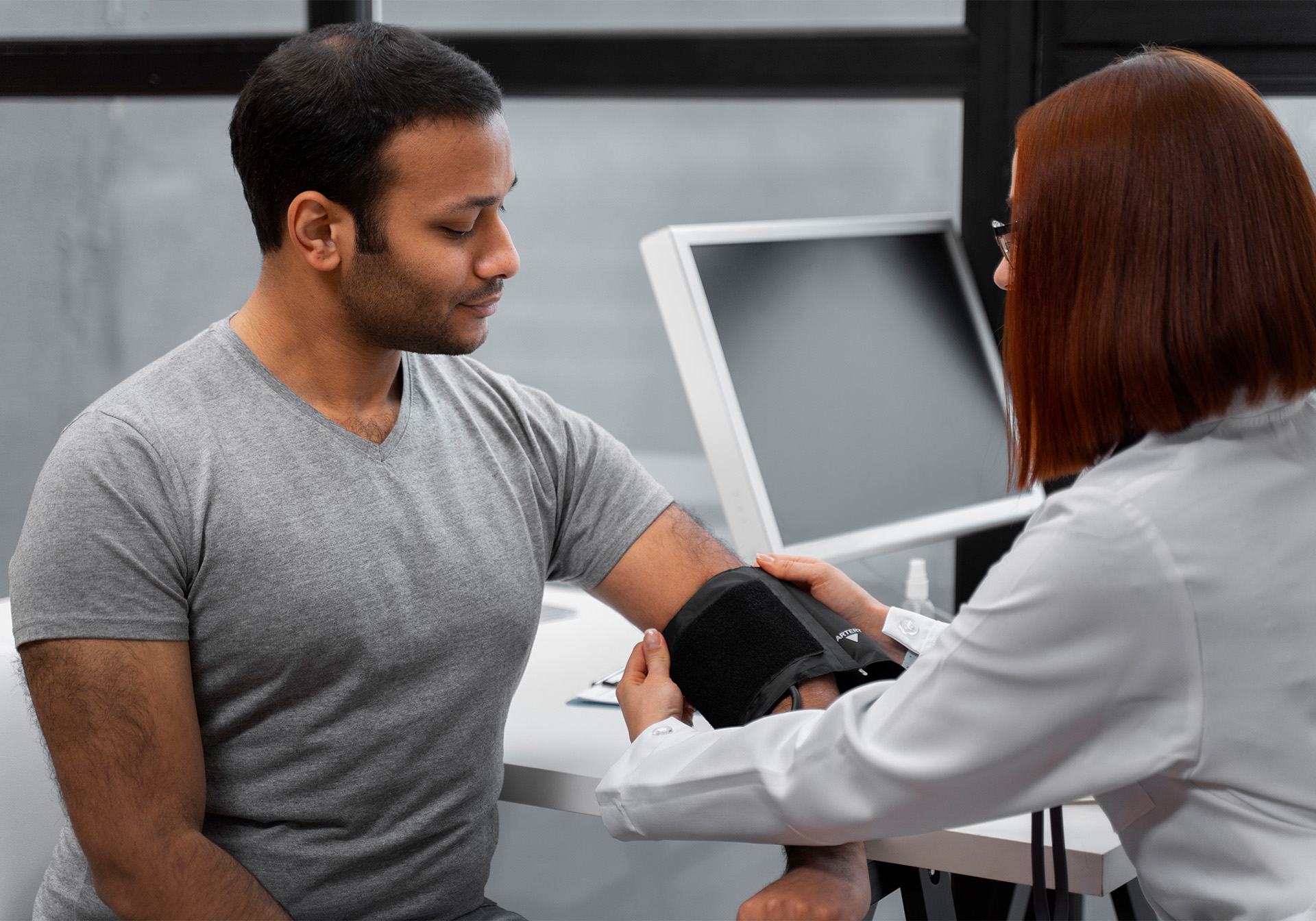
- Blog
- August 25,2024
- 0 Comments
Cardiovascular disease is a leading cause of death in India. According to various sources the other leading causes of death (non communicable disease) are chronic respiratory diseases, cancer, stroke, diabetes, kidney diseases. The most common cause of death due to communicable diseases are malaria, tuberculosis, typhoid, viral hepatitis, HIV-AIDS, dengue and pneumonia. Percentage wise cardiovascular disease accounts for 24.8 % of deaths in India. Others are as follows chronic respiratory diseases 10.2%, cancer 9.4%, and stroke 10%. While the prevention and control of communicable diseases is a public health issue the prevention of non-communicable diseases is a personal issue.
Health screening and preventive action are the answers to reduce the burden of disease due to non communicable diseases.But we need to individualize health screening and prevention to balance between benefits, harms, and costs.There are definite benefits of screening but at the same time there are harms associated with screening –
- Psychological stress and anxiety produced by false-positive screening tests.
- Side effects associated with diagnostic testing after a positive screening test.
- over diagnosis.
- over treatment.
Periodic health check is recommended annually for adults ≥50 years and every three years for adult (without any risk factors) ≤ 49 years. For those under 49 years with risk factors it will be annually.
Obesity
All adult patients should be screened for overweight and obesity by measuring body mass index (BMI) using a BMI calculator. It is also recommend measuring waist circumference in those with BMI between 25 and 35 kg/m2. A waist circumference ≥31 in (80 cm) in Asian females and ≥35 in (90 cm) in Asian males is considered abnormal.
Classification of body mass index –
Underweight – BMI <18.5 kg/m2
Normal weight – BMI ≥18.5 to 24.9 kg/m2
Overweight – BMI ≥25 to 29.9 kg/m2
Obesity – BMI ≥30 kg/m2
- Obesity class 1 – BMI 30 to 34.9 kg/m2
- Obesity class 2 – BMI 35 to 39.9 kg/m2
- Obesity class 3 – BMI ≥40 kg/m2
For Asian individuals overweight is defined as a BMI between 23 and 24.9 kg/m2 and obesity as a BMI >25 kg/m2.
Patients with obesity are at increased risk for heart disease, diabetes, hypertension, dyslipidaemia and have higher overall mortality rates Obesity is also associated with other disorders that has significant morbidity. Examples include osteoarthritis, cholelithiasis, fatty liver, obstructive sleep apnoea, polycystic ovarian syndrome and depression.
Hypertension
Hypertension screening is recommended for adult’s ≥18 years of age. Screening every year for adults ≥40 years and for those who are at high risk* for high blood pressure. Adults aged 18 to 39 years without elevated blood pressure (i.e., <130/80 mmHg) and without cardiovascular disease risk factors should be rescreened for hypertension every three years.
Diagnosis of hypertension in adults –
Clinic BP > 140/90
Self-monitored BP > 135/85
Daytime ambulatory BP > 135/85
- Risk factors for hypertension –
- Smoking
- Alcohol
- Stress
- High salt intake
- Processed food
- Saturated fats
- Dyslipidaemia
- Diabetes
- Physical inactivity
- Lack of sleep
- Drug induced (steroids, cocaine, oestrogen etc. )
- Family history of hypertension
Consequences of hypertension – heart attack, heart failure, brain stroke, chronic kidney disease etc.
Diabetes
Criteria for screening for diabetes or prediabetes in asymptomatic adults –
- Testing should be considered in adults with obesity (BMI ≥25 kg/m2) and any of the following:
- First-degree relative with diabetes
- History of cardiovascular disease
- Hypertension
- HDL cholesterol level <35 mg/dL and/or a triglyceride level >250 mg/dL
- Individuals with polycystic ovary syndrome
- Physical inactivity
- People with prediabetes (A1C ≥5.7% ) should be tested yearly.
- People who were diagnosed with Gestational DM should have lifelong testing at least every 3 years
- For all other people, testing should begin at age 35 years.
- If results are normal, testing should be repeated at a minimum of 3-year intervals
Criteria for the diagnosis of prediabetes in nonpregnant individuals
HbA1C – 5.7–6.4%
Or
Fasting blood sugar — 100 mg/dL to 125 mg/dL
Or
2-h Post prandial blood sugar – 140 mg/dL to 199 mg/dL
Criteria for the diagnosis of diabetes in nonpregnant individuals
HbA1C ≥ 6.5%
Or
Fasting blood sugar ≥ 126 mg/dL
Or
2 hr. Post prandial blood sugar > 200 mg/dl
Or
An individual with classic symptoms of hyperglycaemia (polyphagia/polydipsia/polyuria) or a random plasma glucose ≥200 mg/dL
Risk factors for diabetes
- Obesity
- Genetic
- Lifestyle ( physical inactivity, smoking , alcohol, diet, sleep)
- Metabolic syndrome.
- Polycystic ovarian syndrome.
Consequences of diabetes – heart attack, heart failure, brain stroke, kidney disease, retinopathy, neuropathy, fatty liver, cancer, depression etc.
Hyperlipidaemia
Persons aged 17 to 21 years must undergo one-time screening for hyperlipidaemia.For patients with a normal screen before age 21 who are not at high risk screening for lipid abnormalities should start at age 35 for men and 45 for women.For patients with a normal screen before age 21 who are also at high risk*screening for lipid abnormalities should start at age 25 for men and 35 for women.
*(Patients are considered at high risk if they have more than one risk factor (e.g., diabetes, hypertension, smoking, family history) or a single risk factor that is severe (e.g., several siblings with coronary heart disease in their 40s or a very heavy smoker)
Consequences of hyperlipidaemia – heart attack, heart failure, brain stroke, peripheral arterial disease, aortic aneurysm pancreatitis, hepatosplenomegaly, short-term memory loss etc.
Cardiovascular disease –
Cardiovascular disease (CVD) is caused by atherosclerosis. Atherosclerosis is thickening or hardening of the arteries caused by the build-up of plaque in the inner lining of an artery. It begins as early as 10 to 14 yrs. of age for some and advances quickly to manifest disease in early 30s (juvenile diabetes, familial hyperlipidaemia). In others it may progress slowly to manifest in 50s or 60s.
Atherosclerotic cardiovascular disease (ASCVD) includes four major areas –
- Coronary heart disease manifested by myocardial infarction and angina pectoris
- Cerebrovascular disease manifested by stroke and transient ischemic attack
- Peripheral artery disease manifested by intermittent claudication and limb ischemia
- Aortic atherosclerosis and thoracic or abdominal aortic aneurysm.
ASCVD risk discussions is recommended for all patients between 20 and 75 years of age without known ASCVD.
Identify risk factors — the first step in assessing ASCVD risk is to determine presence of risk factors for ASCVD
- Hypertension.
- Obesity.
- Diabetes mellitus (DM)
- Metabolic syndrome
- Hyperlipidaemia, including known familial hyperlipidaemia
- Cigarette smoking
- Family history of premature ASCVD
- Chronic kidney disease
ASCVD risk assessment –
Following ASCVD risk factor identification and laboratory testing, we assess the patient’s risk of ASCVD by use of a calculator to perform quantitative estimates of either 10-year or 30-year risk, or both.
ASCVD risk assessment calculators –
Prevent (2023)
Predicting Risk of cardiovascular disease EVENTs (PREVENT) calculator
Clinical endpoints – The PREVENT calculator estimates risks of incident ASCVD (MI, fatal CHD, and stroke), HF, and CVD (defined as ASCVD and/or HF). Ten-year risks for these endpoints are estimated for adults aged 30 to 79; 30-year risks are estimated for adults aged 30 to 59.
ASCVD Risk Estimator Plus (2018)
Clinical endpoints – The model estimates 10-year risk of incident ASCVD event for individuals aged 40 to 79 and 30-year (or lifetime) risk for individuals aged 20 to 59 years. An ASCVD event is defined as CHD death, nonfatal MI, fatal stroke, or nonfatal stroke.
Other risk calculators –
SCORE2 (2021), SCORE2-OP (2021), QRISK3 (2018), WHO CVD RISK 2019
When to perform ASCVD risk assessment
- Begin ASCVD risk evaluations at 20 years of age or at first encounter with the health care system beyond 20 years of age.
- Reassess ASCVD risk every five years in patients whose identified 10-year ASCVD risk is low (<5 percent) or borderline (5 to 7.4 percent)
- Reassess ASCVD risk annually for patients whose identified 10-year ASCVD risk is intermediate (7.5 to 19.9 percent) or following the identification of a new risk factor.
*The opinion expressed in the Blog is of Dr Vijay D’Silva
The information provided in the blog is for educational purpose only and does not substitute for professional medical advice, diagnosis or treatment.
Do not ‘self-diagnose/ treat’.
Consult a qualified medical professional for opinion and treatment.





